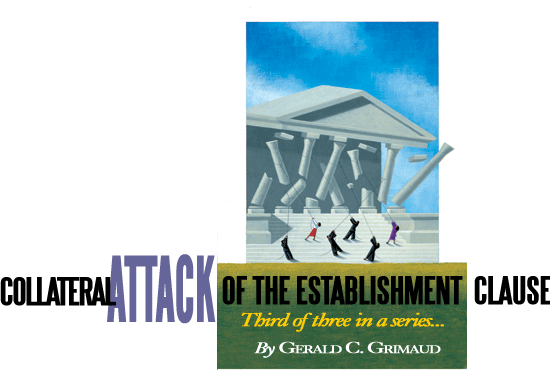Collateral Attack On The Establishment
Gerald C. Grimaud September/October 2003
Illustrations by Scott Roberts

During President Reagan's first term the Christian Coalition's predecessor, the Moral Majority, expended great effort to, in effect, amend the First Amendment. With the support of a popular president they almost succeeded. But for the efforts of U.S. Senator Lowell Weicker of Cohile standing for reelection in 1984, courageously led an extended filibuster against proposed constitutional amendments to allow prayer in public schools.1 In 1992 then Governor Weicker received the Kennedy Foundation's Profile in Courage Award.
Immediately upon taking office President Bush initiated another assault on the establishment clause, an assault unlike any other in history. The president's salvo included his nomination of John Ashcroft for attorney general and two executive orders signed January 29, 2001.
Some say John Ashcroft never met a parochial aid program he didn't like. As a United States senator he championed the 1996 welfare reform provision that has funded religious groups who help welfare recipients enter the workforce.
With one executive order the president set up the White House Office
of Faith-based and Community In-itiatives. The head of this office reports directly to the president, and the office is intended as a liaison to church organizations for identification and government funding purposes.2
With the other executive order the president intends to "clear away the bureaucratic barriers in several important agencies" and establish "centers" within the departments of Justice, Housing and Urban Development, Health and Human Services, Labor, and Education, "to ensure greater cooperation between the government and the independent sector," with an objective of "improving regulatory barriers."3
Having failed in their 1984 frontal attack on the establishment clause, the Christian Coalition, with the assistance of President Bush, is now into a well-planned collateral attack, expecting a sympathetic Rehnquist Supreme Court.4
In my previous essay I expressed fear that the U.S. Supreme Court may find the president's funding of church-based social programs constitutional. My fear stems particularly from the U.S. Supreme Court's decision in Agostini v. Felton,5 a 1997 establishment clause case. Five of the nine justices in Agostini flagrantly disregarded precedent and held public school teachers teaching remedial subjects in parochial schools constitutional. In light of President Bush's initiatives and the Court's Bush v. Gore decision, Agostini looms even larger today than it did three years ago. In Bush v. Gore,6 the same five justices, William Rehnquist, Antonin Scalia, Anthony Kennedy, Clarence Thomas, and Sandra Day O'Connor, again flagrantly discarded precedent by stopping the count in Florida. By these cases that majority demonstrate their willingness to use their power as partisans and not as judges of the law. Justices John Paul Stevens, David Souter, Ruth Ginsburg, and Stephen Breyer dissented in both cases. Through Justice Ginsburg, all four described the majority's decision in Agostini as "unprecedented," an "extraordinary action."
While the line of separation between church and state began to blur and become indistinct in the early 1970s, the Court applied a new test, "excessive entanglement."7 In a 1980 case Justice Stevens8 lamented the falling of the wall. And in the Court's 1985 decision, Wallace v. Jaffree,9 Justice Rehnquist argued in dissent for the wall's complete destruction. Until 1997 the test of constitutionality was whether a parochial aid program involved secular purpose and effect and "excessive entanglements" between religion and government. Now, with Agostini "excessive entanglements" is no longer a standard. And the Rehnquist Court gives little attention to constitutional history in religious liberty cases.
Our majoritarian institutions, presidents and Congress, governors and the general assemblies are not the final arbiters of that which is or is not constitutional. Judicial review, uniquely American, is the genius of our system. The courts are the final guardians of our individual and minority rights. When the majority of the U.S. Supreme Court fails to follow its own precedents, fails to consider the great history and utility of the establishment clause, we're in trouble. However, it's possible a majority of the Court will rise to the occasion when confronted with the president's "faith-based"
program.

Gerald C. Grimaud is a former Pennsylvania assistant attorney general. He is engaged in the general practice of law in his hometown of Tunkhannock, Pennsylvania, including constitutional, criminal, and civil rights law.
1 It takes two thirds of the Congress and three fourths of the states to amend the U S. Constitution; however, it takes only five justices of the
U.S. Supreme Court to interpret the Constitution.
2The New York Times, Jan. 30, 2001, and Feb. 9, 2001.
3 Ibid.
4 During Justice Rehnquist's years on the Court (1971 to the present), and especially since 1997, establishment clause jurisprudence has fundamentally changed to favor parochial aid.
5 521 U.S. 203, 117 S.Ct. 1997.
6 531 U.S. 98 (Dec. 12, 2000).
7 The administrative entanglement test was added in Walz v. Tax Commission, 397 U.S. 664 (1970); Lemon v. Kurtzman, 403 U.S. 602 (1971), the line blurred and became indistinct; Nowak, Rotunda, and Young, Constitutional Law, 2nd ed. (West Publishing, 1983), p. 1031.
8 Committee for Public Education and Religious Liberty v. Regan, 444 U.S. 646, 671 ( J. Stevens, dissenting).
9 422 U.S. 38.